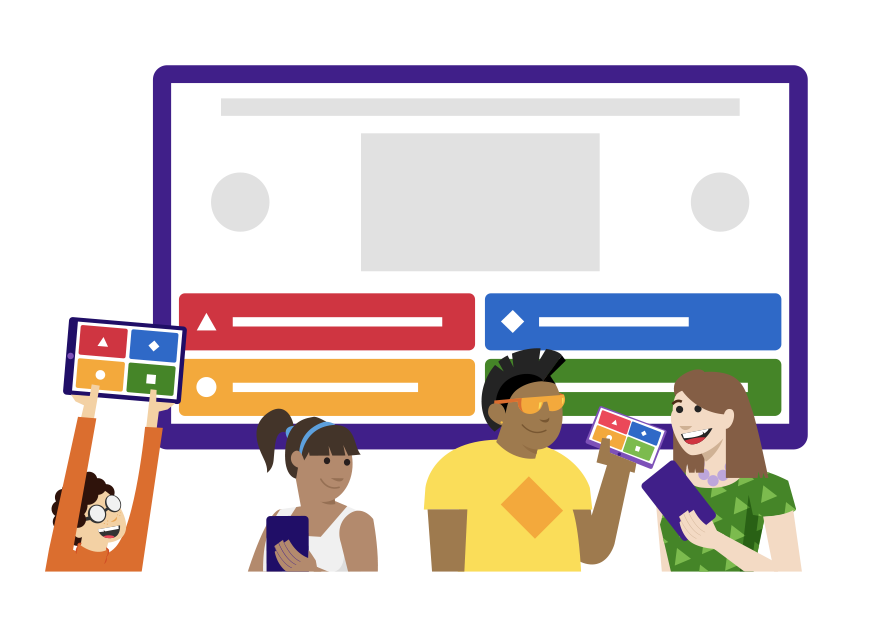EdTech Inquiry by: Emily and Milan
Question: When is the correct time to use Kahoot as a platform for learning and assessment in the classroom?
Kahoot is an online game based learning platform where individuals can create, play and share quizzes on any topic they choose.

Pros:
- Can be anonymous or with names
- Fun and not stressful form of group assessment
- Engaging
- Interactive
- Can work in teams
- Can be specific to teachers needs, unit topic or content
- Motivation to participate
- Less anxiety inducing than other forms of quizzes
- Works with various age levels
- Accessible to different reading levels
- Adaptitable
- Dynamic change in classroom
- Time limits per questions can be adapted
- Tracks wrong answers to see areas of weakness in quiz
- Integrates technology into classroom learning
- Gives clear instructions
Cons:
- Time limits can become stressful for students
- Wifi/technology glitches can impact results
- Requires access to technology and wifi
- Emphasises reaction time over thought out answer (speed over substance)
- Regardless of time allotted, the faster a student answers the higher they score
- Memorization can be a lack of actual understanding
- The “winners” are determined by speed and correctness, not only correctness
Relationship of your topic to teaching and learning
Kahoot can be used as a learning platform and a test of knowledge unrelated to student assessment. By allowing students to individually engage in this platform they can simply get a taste of how much they might know off the top of their head, discover questions they were unsure of, etc. By using this platform, a teacher can allow students to create their own made up name so it is completely anonymous. By having the anonymous factor it may allow students to take risks in their learning and provide growth in their thinking and confidence in the subject.
Implementing in the Classroom
When implementing in the classroom we recommend the teacher be cautious of the grade, subject, and time the kahoot is used for. Some use it as studying tools, some use it as a simple review, and some use it for fun. Regardless, there is a time and place for all classroom platforms and tools. Knowing what your students excel with and need in the classroom is huge. This platform is not something one should implement for students with timed test anxiety, troubles reading, or even just students who require longer for testing and comprehension of what is being asked. Using Kahoot in highschool level courses is a fun way to engage students in simple subject related facts and questions. If one chooses to implement Kahoot in the classroom, our research and experience leads us to advise not using it as a marking/testing tool. Due to various factors that could impact a students performance in this testing platform, it is extremely unfair to mark them off their placement. Kahoot should be used for student benefit and review, with even class discussion over common mistakes.

How do we meet the learning needs of all students in the classroom while using Kahoot?
If making your own Kahoot, the questions are adaptable to be able to have multiple answers per question, providing extra time for reading and allow time for discussion of challenging questions. Time can be a huge obstacle for learners so increasing the available time to answer the question is a useful adaptation to make all learners included. A challenge of this is that it does not level out the class meaning students will still be ranked on how quickly they answer regardless of the available time and a visual ranking of students projected in infront. Because of this speed component, Kahoot has been discussed as a noninclusive platform. Another obstacle is reading ability and reading comprehension. This can be assisted through reading the questions and answered out loud though this impacts their time to answer. When using downloaded pre-made kahoots, sometimes the questions might not be directly related to the content you have taught, making it overwhelming for students. Because of this, it is important to highlight that it is primarily a game to review a topic, learn content, and gain an idea of the level and knowledge of the class. To make this beneficial for all students it is key to not implement this platform too often, to make it clear it is not for direct grading, and to make it fun for all the students. It becomes super engaging and almost competitive in a safe way. Students who are not so academic may find this outlet helpful as it relates to competition and or a race. By remembering this is not a direct teaching lesson tool, it will never become a negative in the classroom. Students will lose nothing from just trying various ways of assessing their knowledge and Kahoot is a great way to do this for many students.
Websites like this share why this tool needs to be stopped in classrooms. They argue it is not to be used as a form of assessment and is implementing speed over substance as a marking of success. From another perspective, this website takes an approach in favour of Kahoot and discusses the important use of games in education.
Risks
- Students lose focus on the material
- Students with quick recall are excelling but leaves other students behind
- Students who struggle with reading feel at a disadvantage and cannot excel equally with their peers
- The way the questions are formatted can become tricky, confusing, and or unfair
Comparing other platforms:
Another testing and studying platform that can become very helpful is quizlet. Quizlet allows students to create their own type of testing and studying decks. By students creating their own studying material it benefits them in their learning. Quizlet also can have various ways of testing the material imputed such as; true or false, match, compare, short answer and more. This can be appealing for students who are anxious to show their work and who struggle to present under pressure from others. Blackboard is another site similar. These sites have similar models of quizzing students over a variety of topics and being an interactive way of learning. The main issue with many of these is that they cost money to use or cost money to have a well performing version of the platform with enough features to create and share meaningful content. Kahoot has a free base model of the platform and is accessible for use in the classroom for free. It’s many features make engaging and personalized quizzes while giving access to thousands of public pre-made quizzes.
Types of question formats that can be used/asked:
True or False:
4 Option Answer:
Poll:
Type Answer:
Read Aloud:
Puzzle:





